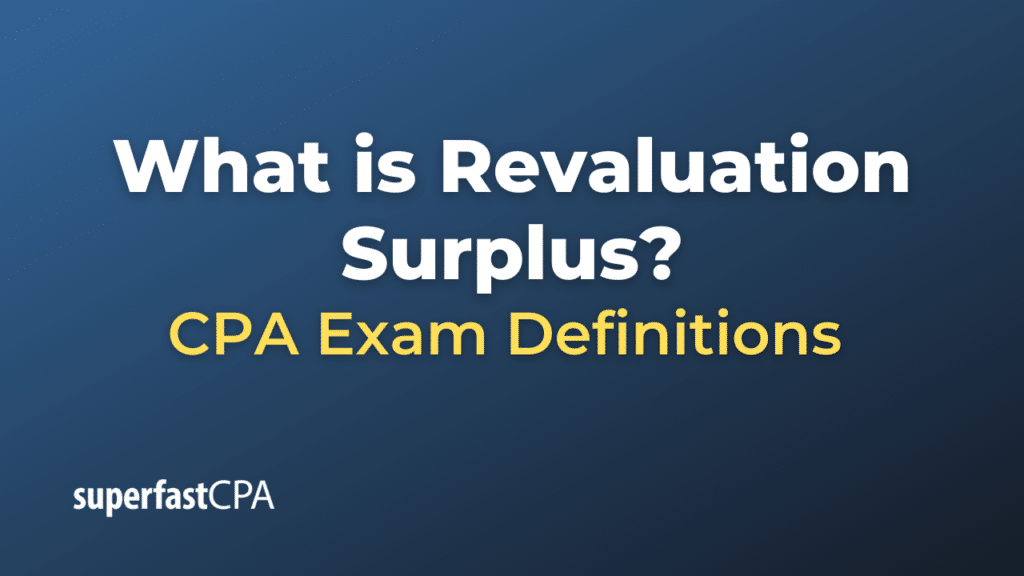Revaluation Surplus
Revaluation surplus is an equity account used in financial accounting that captures increases in the fair value of an asset over its previous carrying amount (book value). It’s typically used under the Revaluation Model of accounting for fixed assets, particularly in systems that follow the International Financial Reporting Standards (IFRS).
When an asset is revalued upwards, the increase in value (the difference between the asset’s new fair value and its previous carrying amount) is credited to the revaluation surplus account. Conversely, a decrease in an asset’s value due to revaluation would first be offset against any previous revaluation surpluses related to the same asset before being recognized as an expense.
Key Points Regarding Revaluation Surplus:
- Equity Account: The revaluation surplus is an equity account, which means it represents part of the owner’s equity in the company. However, this equity is not typically distributable as dividends because it represents unrealized gains on assets.
- Usage: Revaluation surplus is used when assets, usually long-term tangible assets like land and buildings, are revalued to their current market values.
- Decrease in Value: If an asset’s value is decreased upon revaluation, the decrease is first charged against any existing revaluation surplus for that asset. If the decrease exceeds the available surplus, the excess is recognized as a loss in the income statement.
- Sale of Revalued Asset: When a revalued asset is sold, the portion of the revaluation surplus that relates to that asset can be transferred to retained earnings. This is because the surplus, which was previously unrealized, becomes realized upon the sale of the asset. However, it doesn’t pass through the income statement.
Example of Revaluation Surplus
GreenTech Ltd., a manufacturing company, owns a piece of industrial land. This land was bought 5 years ago at a price of $2 million. Due to a recent infrastructural boom in the area, property values have skyrocketed.
Year 5:
- Decision to Revalue: Given the developments, GreenTech Ltd. decides to revalue its land to reflect the current market value.
- Hiring an Expert: GreenTech hires a professional real estate valuer who assesses the current market value of the land to be $3 million.
- Revaluation Surplus Calculation: The increase in value = Current market value – Original value = $3 million – $2 million = $1 million.
Accounting Entries in Year 5:
- Debit Land (asset account) by $1 million (raising its value to the new market value of $3 million).
- Credit Revaluation Surplus (equity account) by $1 million (capturing the increase in asset value).
Year 6:
By the end of the next year, due to some unforeseen economic factors, the value of the land drops to $2.5 million.
- Revaluation Decrease Calculation: The decrease in value = Previous revalued amount – New value = $3 million – $2.5 million = $500,000.
- Since GreenTech has a revaluation surplus of $1 million from the previous year, the decrease of $500,000 will be adjusted against this surplus.
Accounting Entries in Year 6:
- Debit Revaluation Surplus (equity account) by $500,000 (reducing the surplus due to the decrease in land value).
- Credit Land (asset account) by $500,000 (bringing the asset’s value down to $2.5 million).
After this entry, GreenTech will still have a Revaluation Surplus balance of $500,000 ($1 million – $500,000) related to the land.
Year 8:
GreenTech Ltd. decides to sell the land for $2.8 million, realizing a gain of $300,000 over its carrying amount of $2.5 million. This gain is recognized in profit or loss for the year. However, the revaluation surplus that was previously recognized in equity (and hasn’t been used to offset any revaluation losses) can now be transferred directly to retained earnings.
Accounting Entries on Sale in Year 8:
- Debit Cash (asset account) by $2.8 million (for sale proceeds).
- Credit Land (asset account) by $2.5 million (derecognizing the asset).
- Credit gain on sale of Land (income account) by $300,000 (the gain on sale).
- Transfer the remaining Revaluation Surplus directly to Retained Earnings in equity.
This example highlights how revaluation surplus captures increases in asset values, how it’s used to absorb decreases in those values, and how it’s handled upon the sale of the revalued asset.













